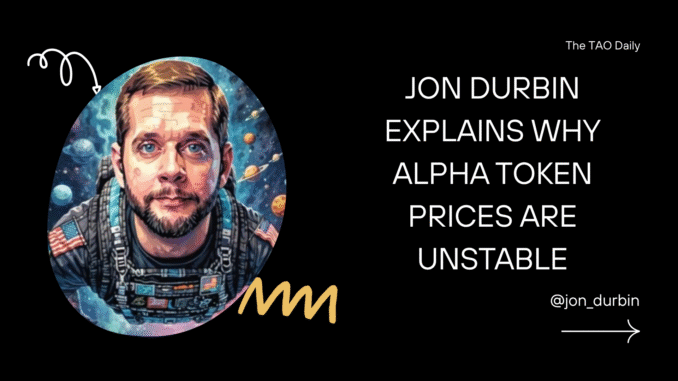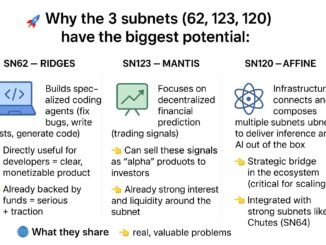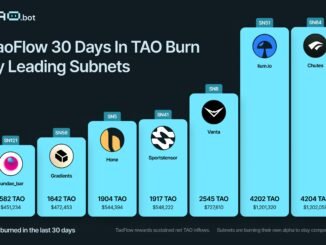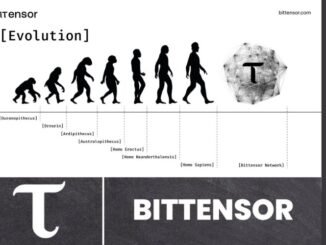
In the broad crypto space, token price volatility is a common concern for investors and participants. Jon Durbin, a backend dev for Chutes (Bittensor subnet SN64), recently addressed a user’s complaint about the consistent decline in Chutes’ alpha token price.
In his detailed response on X, Durbin breaks down the instability into three key factors, drawing from the mechanics of dTAO and broader market behaviors.
While his explanation centers on Chutes, it offers broader insights into why alpha tokens across subnets can fluctuate wildly.
1. The Inherent Design of dTAO and Normalization Toward Unity
Durbin starts by pointing to the foundational mechanics of dTAO. He explains: “dTAO was essentially ‘programmed’ to have a sum of subnets =~ 1.” This means the total value across all subnets tends to normalize around 1, creating downward pressure on early entrants.
Many investors bought in when this ratio was significantly higher than 1, and even today, it’s still greater than 1.
Durbin notes there were “many warnings to not buy alpha tokens early on,” but unfortunately, some people (or perhaps intentionally, with a long-term hold strategy in mind) got hurt by this inevitable trend back to 1. This dilution effect redistributes emissions over time, eroding early gains and contributing to price instability as the system self-corrects.
2. PvP Dynamics and Limited External Capital Inflows
What Durbin considers “probably more relevant” is the player-versus-player (PvP) nature of dTAO, amplified by the scarcity of new capital entering the ecosystem. He elaborates: “There’s very little external inflow of funds into subnets,” leading to more internal shuffling than genuine growth.
To illustrate, he describes how “there is more movement between subnets than external inflows.” For instance, a staker who previously backed Chutes might unstake to support another subnet like Ridges AI. This results in a “loss of stake for Chutes = less TAO injection into pool = lower alpha token price (while at the same time, the value of the alpha token they purchased with the funds removed from Chutes goes up).”
Without substantial new capital being allocated broadly, these shifts between subnets create frequent fluctuations, turning the ecosystem into a zero-sum game where one subnet’s gain is another’s loss.
3. Investor Expectations: Instant Profitability vs. Steady Growth
The third factor stems from staker feedback and differing investment philosophies. Durbin shares that large stakers who “dumped Chutes” often cited a desire for “profitability instantly,” believing other subnets might achieve this faster. Chutes, he defends, is “on the path of steady revenue growth and we’re doing extremely well compared to web2 tech companies.” However, some prefer “speculative plays with the idea that some subnets will have a 0->1 moment and snowball.” While acknowledging this possibility, he urges “some amount of caution and avoid irrational exuberance.”
A related criticism is overpaying miners for excess compute. Durbin concedes this is “definitely understandable” but counters with two points: First, Chutes is developing a “savings” plan for miners, involving “time-locking a portion of emissions in smart contract so they can’t be sold/dumped” (he disagrees with burning emissions), with rewards for saving more. Second, this setup provides “insanely cheap infrastructure,” enabling rapid deployment of new AI models.
Chutes itself exemplifies steady progress: “We did not have a 0->1 instant profitability growth, rather we’ve ~10x’d revenue in 3 months, and have only a 3-4x remaining to become profitable (in the sense of fully offsetting miner emissions).”
Investor Mindsets in the Bittensor Ecosystem
Durbin concludes by outlining three prevailing mindsets for alpha token investors:
- Invest in steady growth subnets more like traditional web2 companies (examples: Chutes, Lium, Targon, etc.).
- Invest in subnets you may believe will have explosive instantaneous revenue (examples: Ridges, Affine, Sportstensor, etc.).
- Degenerate gambling—high-risk bets without a clear strategy.
His analysis highlights the tension between short-term speculation and long-term value creation in Bittensor. As the ecosystem matures—especially with an upcoming TAO halving that could halve emissions and shift unit economics—understanding these dynamics is crucial for navigating alpha token instability.
Durbin’s candid insights remind us that while volatility is baked in, informed strategies can mitigate risks.




Be the first to comment